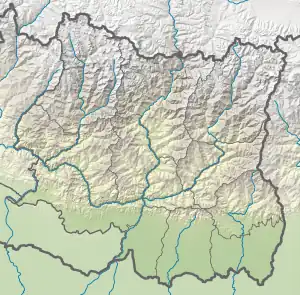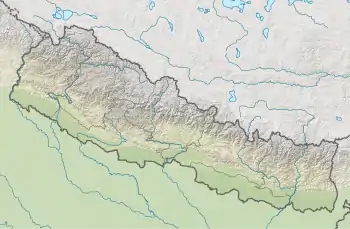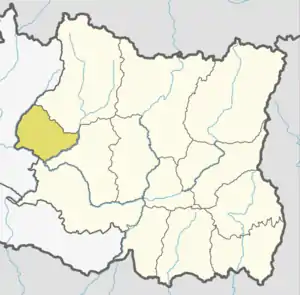Chisankhugadhi Rural Municipality
Chisankhugadhi (Nepali: चिशंखुगढी गाउँपालिका) is a rural municipality (gaunpalika) out of seven rural municipality located in Okhaldhunga District of Province No. 1 of Nepal. There are a total of 8 municipalities in Okhaldhunga in which 1 is urban and 7 are rural.[2]
Chishankhugadhi
चिशंखुगढी गाउँपालिका | |
|---|---|
| Nickname: Chishankhu | |
| Motto(s): "कृषि, पर्यटन, र दिगो पूर्वाधार, समृद्ध चिशंखुगढीको बलियो आधार" | |
 Chishankhugadhi Location in Province No. 1  Chishankhugadhi Chishankhugadhi (Nepal) | |
| Coordinates: 27.32°N 86.63°E | |
| Province | Province No. 1 |
| District | Okhaldhunga |
| Wards | 8 |
| Established | 10 March 2017 |
| Government | |
| • Type | Rural Council |
| • Chairperson | Mr. Nishant Sharma (NCP) |
| • Vice-chairperson | Mr. Santosh Babu Thapa (Nepali Congress)[1] |
| Area | |
| • Total | 126.91 km2 (49.00 sq mi) |
| Population (2011) | |
| • Total | 15,196 |
| • Density | 120/km2 (310/sq mi) |
| Time zone | UTC+5:45 (Nepal Standard Time) |
| Headquarter | Serna |
| Website | official website |
According to Ministry of Federal Affairs and Local Developme Chisankhugadhi has an area of 126.91 square kilometres (49.00 sq mi) and the total population of the municipality is 15196 as of Census of Nepal 2011.[3][4]
Kuibhir, Pokhare, Diyale, Ratmata, Serna, Bhadaure and Mamkha which previously were all separate Village development committee merged to form this new local level body. Fulfilling the requirement of the new Constitution of Nepal 2015, Ministry of Federal Affairs and Local Development replaced all old VDCs and Municipalities into 753 new local level body (Municipality).[3][2]
The rural municipality is divided into total 8 wards and the headquarter of this newly formed rural municipality is situated in Serna.[3]
Demographics
At the time of the 2011 Nepal census, Chisankhugadhi Rural Municipality had a population of 15,206. Of these, 59.4% spoke Nepali, 16.8% Magar, 10.3% Bahing, 3.2% Sherpa, 3.0% Tamang, 3.0% Thulung, 2.4% Rai, 1.2% Majhi and 0.7% other languages as their first language.
In terms of ethnicity/caste, 20.7% were Chhetri, 19.7% Magar, 12.6% Hill Brahmin, 7.6% Rai, 5.5% Newar, 5.1% Kami, 4.7% Bahing, 4.5% Sarki, 3.8% Gharti/Bhujel and 15.8% others.
In terms of religion, 80.7% were Hindu, 12.0% Kirati, 6.4% Buddhist, 0.6% Christian and 0.3% others.[5]
References
- "Maoist Centre Wins Chishankhugadhi Rural Municipality in Okhaldhunga".
- "हेर्नुहोस्, तपाईं कुन गाउँपालिका वा नगरपालिकामा पर्नुभयो?". setopati. Archived from the original on 2017-03-12. Retrieved 19 April 2018.
- "स्थानीय तहहरुको विवरण". www.mofald.gov.np/en. MoFALD. Archived from the original on 31 August 2018. Retrieved 19 April 2018.
- "CITY POPULATION – statistics, maps & charts". www.citypopulation.de. 8 October 2017. Retrieved 19 April 2018.
- NepalMap Demographics
